1997 TOYOTA 4RUNNER brake light
[x] Cancel search: brake lightPage 72 of 223
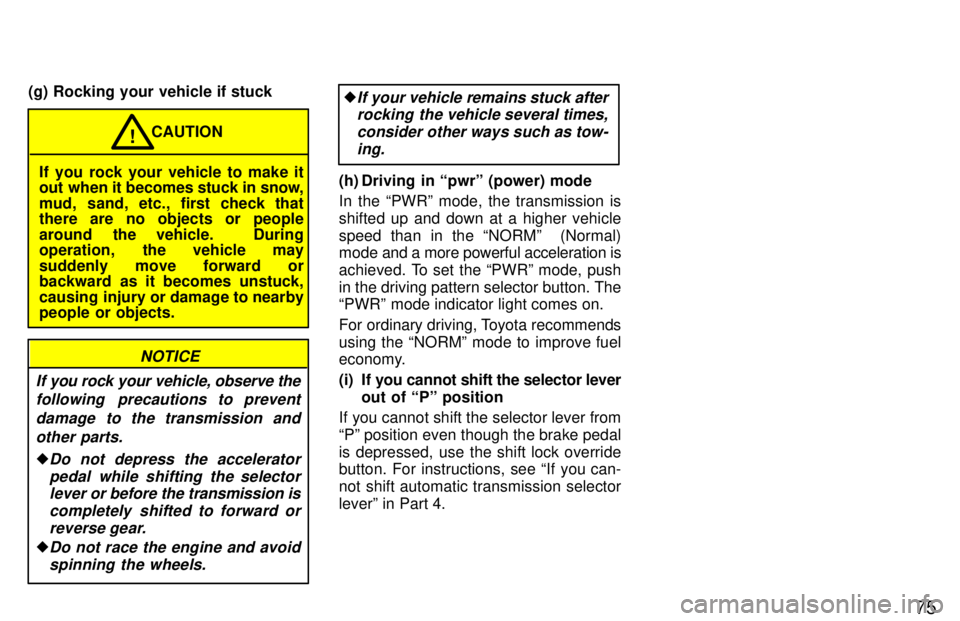
75
(g) Rocking your vehicle if stuck
If you rock your vehicle to make it
out when it becomes stuck in snow,
mud, sand, etc., first check that there are no objects or people
around the vehicle. During
operation, the vehicle may suddenly move forward or
backward as it becomes unstuck,
causing injury or damage to nearby
people or objects.
CAUTION
!
NOTICE
If you rock your vehicle, observe the following precautions to prevent
damage to the transmission andother parts.
�Do not depress the acceleratorpedal while shifting the selectorlever or before the transmission is
completely shifted to forward or
reverse gear.
�Do not race the engine and avoidspinning the wheels.
�If your vehicle remains stuck afterrocking the vehicle several times,
consider other ways such as tow-ing.
(h) Driving in pwrº (power) mode
In the PWRº mode, the transmission is shifted up and down at a higher vehicle
speed than in the NORMº (Normal) mode and a more powerful acceleration is
achieved. To set the PWRº mode, push
in the driving pattern selector button. The
PWRº mode indicator light comes on.
For ordinary driving, Toyota recommends
using the NORMº mode to improve fuel
economy.
(i) If you cannot shift the selector lever out of Pº position
If you cannot shift the selector lever from Pº position even though the brake pedal
is depressed, use the shift lock override
button. For instructions, see If you can- not shift automatic transmission selectorleverº in Part 4.
Page 74 of 223

77
Your automatic transmission has a shift
lock system to minimize the possibility of
incorrect operation. This means you can
only shift out of Pº position when the brake
pedal is depressed (with the ignition
switch in ONº position and the selector le- ver pulled toward you).
(a) Normal driving
1. Start the engine as instructed in How to start the engineº in Part 3. The trans- mission must be in Pº or Nº.
When the front drive control lever is in L4º
(low-speed position, four-wheel drive),
the driving pattern selector setting has no
effect on gear shift timing. (See Four-
wheel drive systemº in this chapter for in-
formation of the front drive control lever.)
2. With your foot holding down the brake pedal, shift the selector lever to Dº.
In Dº position, the automatic transmis-
sion system will select the most suitable
gear for running conditions such as nor-
mal cruising, hill climbing, hard towing, etc. Always turn the overdrive switch on for
better
fuel economy and quieter driving. If
the engine coolant temperature is low or
when the front drive control lever is in l4º
(low-speed position, four-wheel drive)
the transmission will not shift into the
overdrive gear even with the overdrive
switch on. ( See Fourwheel drive systemº
in this chapter for information of the front
drive control lever.)
Never put your foot on the accelera- tor pedal while shifting. CAUTION
!
3. Release the parking brake and brake pedal. Depress the accelerator pedal
slowly for smooth starting.
(b) Using engine braking
To use engine braking, you can downshift the transmission as follows: � Turn off the overdrive switch. The O/D
OFFº indicator light will come on andthe transmission will downshift to the
third gear. �
Shift into the 2º position. The trans-
mission will downshift to the second
gear when the vehicle speed drops
down to or lower than following speed,
and more powerful engine braking will
be obtained.
Front drive control lever in H2º or H4º
3RZ-FE engine 105 km/h (65 mph) . .
5VZ-FE engine 114 km/h (70 mph) . . .
Front drive control lever in L4º 3RZ-FE engine 38 km/h (23 mph) . . . .
5VZ-FE engine 41 km/h (25 mph) . . . .
� Shift into the Lº position. The trans- mission will downshift to the first gear
when the vehicle speed drops down to
or lower than the following speed, and
maximum engine braking will be ap- plied.
Front drive control lever in H2º or H4º
3RZ-FE engine 51 km/h (31 mph) . . . .
5VZ-FE engine 55 km/h (34 mph) . . . .
Front drive control lever in L4º 3RZ-FE engine 11 km/h (6 mph) . . . . .
5VZ-FE engine 12 km/h (7 mph) . . . . .
Page 76 of 223
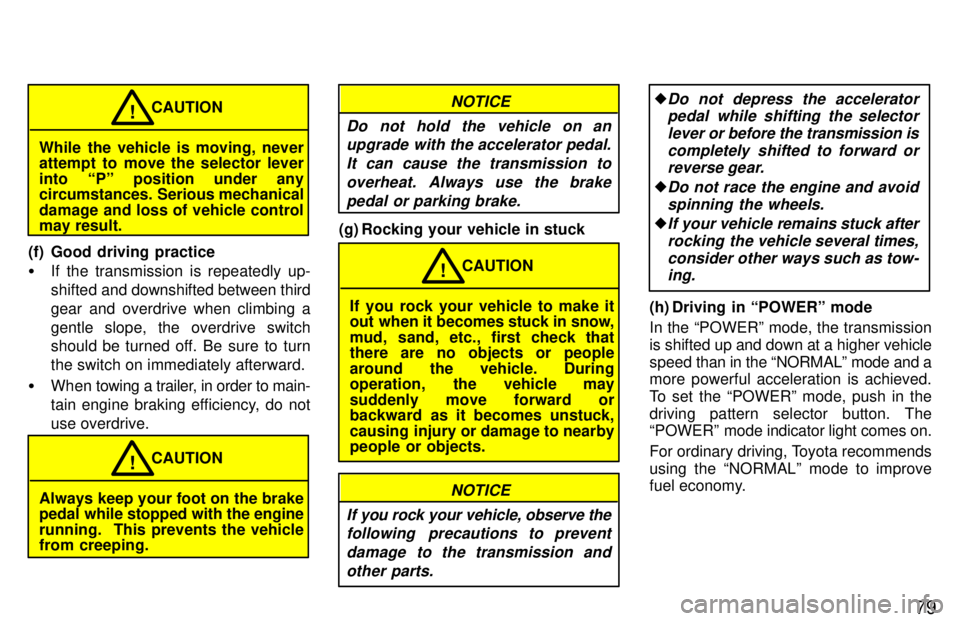
79
While the vehicle is moving, never
attempt to move the selector lever
into Pº position under any
circumstances. Serious mechanical
damage and loss of vehicle control may result.CAUTION
!
(f) Good driving practice � If the transmission is repeatedly up-
shifted and downshifted between third
gear and overdrive when climbing a
gentle slope, the overdrive switch
should be turned off. Be sure to turn the switch on immediately afterward.
� When towing a trailer, in order to main-
tain engine braking efficiency, do notuse overdrive.
Always keep your foot on the brake
pedal while stopped with the engine
running. This prevents the vehicle
from creeping. CAUTION
!
NOTICE
Do not hold the vehicle on an upgrade with the accelerator pedal.
It can cause the transmission tooverheat. Always use the brake pedal or parking brake.
(g) Rocking your vehicle in stuck
If you rock your vehicle to make it
out when it becomes stuck in snow,
mud, sand, etc., first check that there are no objects or people
around the vehicle. During
operation, the vehicle may suddenly move forward or
backward as it becomes unstuck,
causing injury or damage to nearby
people or objects. CAUTION
!
NOTICE
If you rock your vehicle, observe the following precautions to prevent
damage to the transmission andother parts.
�Do not depress the acceleratorpedal while shifting the selector
lever or before the transmission is
completely shifted to forward or reverse gear.
�Do not race the engine and avoid
spinning the wheels.
�If your vehicle remains stuck afterrocking the vehicle several times,consider other ways such as tow-ing.
(h) Driving in POWERº mode In the POWERº mode, the transmission
is shifted up and down at a higher vehicle
speed than in the NORMALº mode and a
more powerful acceleration is achieved.
To set the POWERº mode, push in the
driving pattern selector button. The
POWERº mode indicator light comes on.
For ordinary driving, Toyota recommends
using the NORMALº mode to improve
fuel economy.
Page 82 of 223

85
With A.D.D.
To shift from H2º to H4º
, reduce your
speed to less than 80 km/h (50 mph) and
move the front drive control lever.
If you have trouble shifting in cold weath-
er, reduce your speed or stop the vehicle and reshift.
Never move the front drive control
lever if wh eels are slipping. Stop the
slipping or spinning before shifting. CAUTION
!
To shift from H4º to H2º , simply move
the front drive control lever. Also, disen-
gage both the free-wheeling hubs for con-
tinued H2º use. This can be done at any vehicle speed.
If the indicator light does not go off when you shift the transfer into H2º, drive
straight ahead while accelerating or de- celerating, or drive in reverse. SHIFTING BETWEEN H4º AND L4º
To shift between H4º and L4º , stop
the vehicle and put the transmission in
Nº. With your foot holding down the brake
pedal, move the front drive control lever. SHIFTING BETWEEN H2º AND H4º
To shift from H2º to H4º
, reduce your
speed to less than 100 km/h (62 mph) and
push in the 4WDº button. You need not depress the clutch pedal.
If the indicator light does not come on
when you push in the 4WDº button, drive
straight ahead while accelerating or de-celerating.
If the indicator light flashes and the buzzer
sounds when you push in the 4WDº but-
ton, reduce your speed or stop the vehicle
and reset.
Never push the 4WDº button if
wheels are slipping. Stop the
slipping or spinning before shifting. CAUTION
! To shift from H4º to H2º
, push the
4WDº button aging to turn it off.
This can be done at any vehicle speed.
You need not depress the clutch pedal.
If the indicator light does not go off when you shift the transfer into H2º, drive
straight ahead while accelerating or de- celerating, or drive in reverse.
SHIFTING BETWEEN H2º OR H4º
AND L4º
To shift from H2º or H4º to L4º , stop
the vehicle or reduce your speed to less
than 8 km/h (5 mph). With your foot off the
accelerator pedal, depress the clutch
pedal and move the front drive control le-
ver.
To shift from L4º to H2º or H4º , de-
press the clutch pedal and move the front
drive control lever. When the 4WDº but-ton is pushed in, the transfer shifts into
H4º; when the button is left out, the trans-
fer shifts into H2º This can be done at any vehicle speed.
If the indicator light does not go off when you shift the transfer into H2º, drive
straight ahead while accelerating or de- celerating, or drive in reverse.
(c) Shifting procedure (lever/button type)
Page 84 of 223
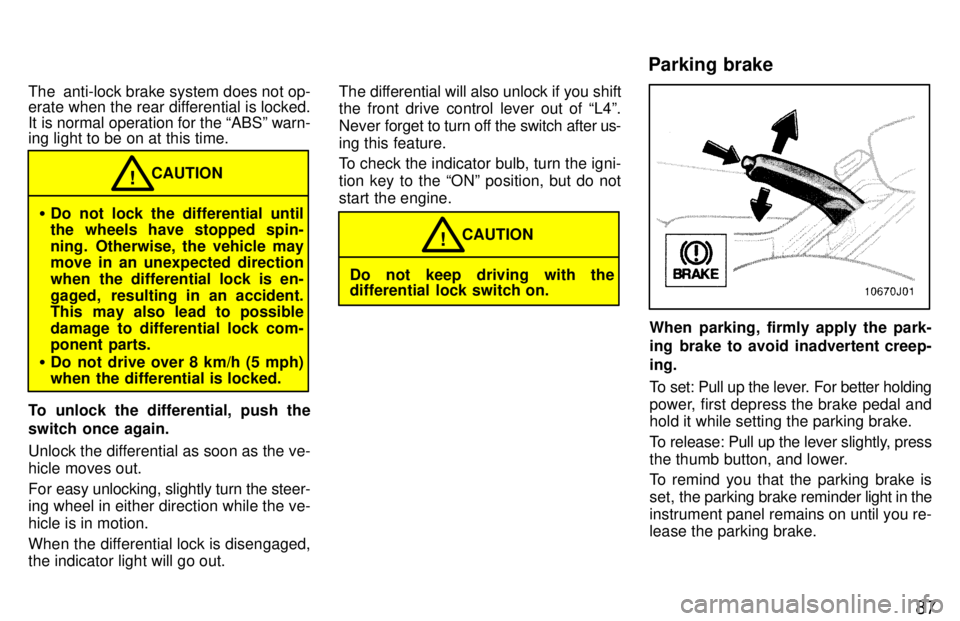
87
The anti-lock brake system does not op-
erate when the rear differential is locked.
It is normal operation for the ABSº warn-
ing light to be on at this time.
�
Do not lock the differential until
the wheels have stopped spin-
ning. Otherwise, the vehicle may
move in an unexpected direction
when the differential lock is en-
gaged, resulting in an accident.
This may also lead to possible
damage to differential lock com-
ponent parts.
� Do not drive over 8 km/h (5 mph)
when the differential is locked. CAUTION
!
To unlock the differential, push the
switch once again.
Unlock the differential as soon as the ve- hicle moves out.
For easy unlocking, slightly turn the steer-
ing wheel in either direction while the ve- hicle is in motion.
When the differential lock is disengaged, the indicator light will go out. The differential will also unlock if you shift
the front drive control lever out of L4º. Never f
orget to turn off the switch after us-
ing this feature.
To check the indicator bulb, turn the igni-
tion key to the ONº position, but do not
start the engine.
Do not keep driving with the
differential lock switch on. CAUTION
!
When parking, firmly apply the park-
ing brake to avoid inadvertent creep- ing.
To set: Pull up the lever. For better holding
power, first depress the brake pedal and
hold it while setting the parking brake.
To release: Pull up the lever slightly, press
the thumb button, and lower.
To remind you that the parking brake is
set,
the parking brake reminder light in the
instrument panel remains on until you re- lease the parking brake.
Parking brake
Page 85 of 223
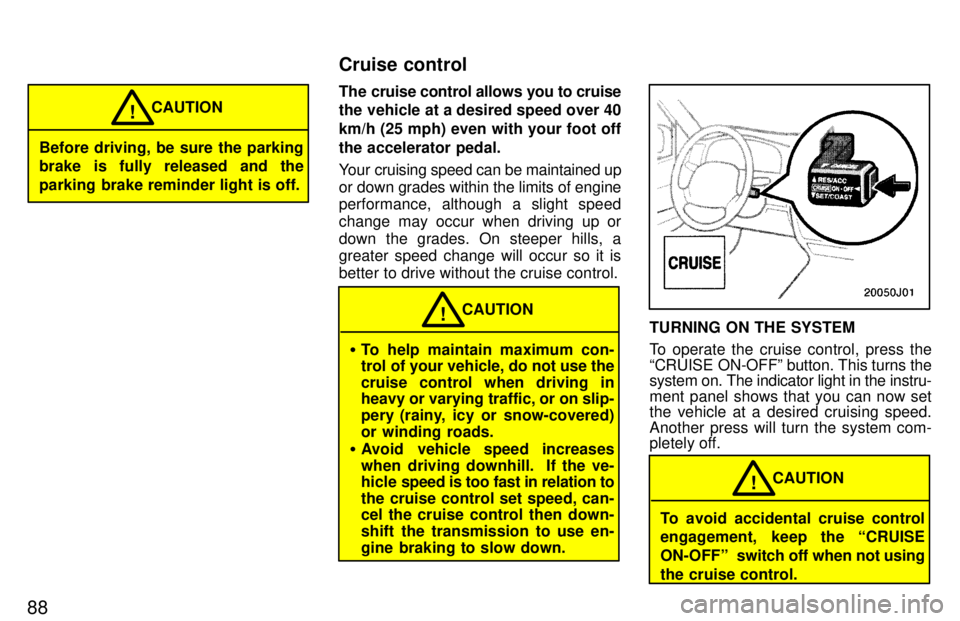
88
Before driving, be sure the parking
brake is fully released and the
parking brake reminder light is off.CAUTION
!
The cruise control allows you to cruise
the vehicle at a desired speed over 40 km/h (25 mph) even with your foot offthe accelerator pedal.
Your cruising speed can be maintained up
or down grades within the limits of engine
performance, although a slight speed
change may occur when driving up or
down the grades. On steeper hills, a greater speed change will occur so it is
better to drive without the cruise control.
�
To help maintain maximum con-
trol of your vehicle, do not use the
cruise control when driving in heavy or varying traffic, or on slip-
pery (rainy, icy or snow-covered)
or winding roads.
� Avoid vehicle speed increases
when driving downhill. If the ve-
hicle speed is too fast in relation to
the cruise control set speed, can-
cel the cruise control then down-
shift the transmission to use en-
gine braking to slow down. CAUTION
!TURNING ON THE SYSTEM
To operate the cruise control, press the
CRUISE ON-OFFº button. This turns the system on. The indicator light in the instru-
ment panel shows that you can now set
the vehicle at a desired cruising speed.
Another press will turn the system com-
pletely off.
To avoid accidental cruise control
engagement, keep the CRUISE
ON-OFFº
switch off when not using
the cruise control. CAUTION
!
Cruise control
Page 87 of 223

90On vehicles with automatic transmission,
even if you turn off the overdrive switch with the cruise control on, engine braking
will
not be applied because the cruise con-
trol is not cancelled. To decrease the ve-
hicle speed, reset to a slower speed with
the cruise control lever or depress the brake pedal. If you use the brake pedal, cruise control is cancelled. RESUMING THE PRESET SPEED
If the preset speed is cancelled by pulling
the control lever or by depressing the
brake pedal or clutch pedal, pushing the
lever up in the RES/ACCº direction will
restore the speed set prior to cancellation.
However, once the vehicle speed falls be-
low about 40 km/h (25 mph), the preset
speed will not be resumed.
CRUISE CONTROL FAILURE WARN- ING
If the CRUISEº indicator light in the in-
strument cluster flashes when using the
cruise control, press the CRUISE ON-
OFFº button to turn the system off and then press it again to turn it on. If any of the following conditions then oc-
curs, there is some trouble in the cruise control system. �
The indicator light does not come on.
� The indicator light flashes again.
� The indicator light goes out after it
comes on.
If this is the case, contact your Toyota
dealer and have your vehicle inspected.
To crank the engine without depress- ing the clutch pedal, push the switch
with the ignition on.
The switch stays on as long as the ignition
is on. And it will automatically turn off
when the ignition is off.
This switch cancels the clutch start sys-
tem, which is designed to keep the starter
motor from operating if the clutch pedal is
not depressed all the way down.
The switch allows the vehicle to be driven
out of difficult situations by cranking the
engine with the clutch engaged.
Clutch start cancel switch (four-wheel drive models with manual transmission)
Page 138 of 223
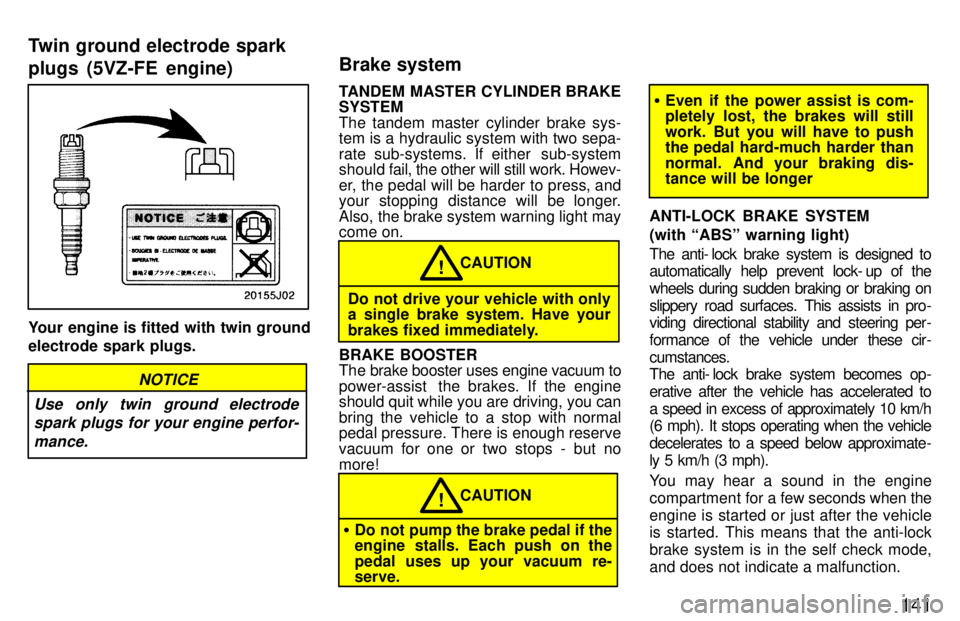
141
Your engine is fitted with twin ground electrode spark plugs.
NOTICE
Use only twin ground electrode spark plugs for your engine perfor-
mance.
TANDEM MASTER CYLINDER BRAKE SYSTEM
The tandem master cylinder brake sys-
tem is a hydraulic system with two sepa-
rate sub-systems. If either sub-system
should fa il, the other will still work. Howev-
er, the pedal will be harder to press, and
your stopping distance will be longer.
Also, the brake system warning light may come on.
CAUTION!
Do not drive your vehicle with only a single brake system. Have your
brakes fixed immediately.
BRAKE BOOSTER
The brake booster uses engine vacuum to
power-assist the brakes. If the engine
should quit while you are driving, you can
bring the vehicle to a stop with normal
pedal pressure. There is enough reserve
vacuum for one or two stops - but nomore!
CAUTION!
� Do not pump the brake pedal if the
engine stalls. Each push on the
pedal uses up your vacuum re- serve.
�Even if the power assist is com-
pletely lost, the brakes will still
work. But you will have to push
the pedal hard-much harder than
normal. And your braking dis- tance will be longer
ANTI-LOCK BRAKE SYSTEM (with ABSº warning light)
The anti- lock brake system is designed to
automatically help prevent lock- up of the
wheels during sudden braking or braking on
slippery road surfaces. This assists in pro-
viding directional stability and steering per -
formance of the vehicle under these cir -
cumstances.
The anti- lock brake system becomes op-
erative after the vehicle has accelerated to
a speed in excess of approximately 10 km/h
(6 mph). It stops operating when the vehicle
decelerates to a speed below approximate-
ly 5 km/h (3 mph).
You may hear a sound in the engine
compartment for a few seconds when the
engine is started or just after the vehicle is started. This means that the anti-lock
brake system is in the self check mode,
and does not indicate a malfunction.
Twin ground electrode spark plugs (5VZ-FE engine)
Brake system